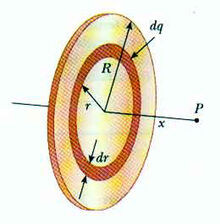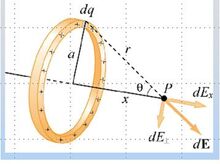Tag: Visual edit |
Tag: Visual edit |
||
| Line 36: | Line 36: | ||
:<math display="block"> E_x = \frac{\sigma x}{2 {\epsilon}_{0}} \left( -\frac{1}{\sqrt{x^2 + R^2}} + \frac{1}{x} \right). </math> |
:<math display="block"> E_x = \frac{\sigma x}{2 {\epsilon}_{0}} \left( -\frac{1}{\sqrt{x^2 + R^2}} + \frac{1}{x} \right). </math> |
||
| + | Therefore, the electric field a distance <math> x </math> along the axis from a disc of radius <math> R </math> and uniform charge density <math> \sigma </math>is |
||
| − | Therefore, |
||
:<math display="block"> E = \frac{\sigma}{2 {\epsilon}_{0}} \left(1 -\frac{x}{\sqrt{x^2 + R^2}} \right) \boldsymbol{i}. </math> |
:<math display="block"> E = \frac{\sigma}{2 {\epsilon}_{0}} \left(1 -\frac{x}{\sqrt{x^2 + R^2}} \right) \boldsymbol{i}. </math> |
||
<br /> |
<br /> |
||
Latest revision as of 20:58, 18 April 2022
Problem

Figure 1. Disc of radius R
Find the electric field a distance along the axis from a disc of radius and uniform charge density .
Hint
(1) Think of this disk as a bunch of concentric rings. Begin by finding the electric field a distance along the axis up from a thin ring of charge and radius .
(2) You may use the integral
Solution

Figure 2. Electric field at point P
Consider the ring problem first. Due to the symmetry of this geometry, there is a cancellation effect in the y-direction. Therefore, all contributions to the electric field in the x-direction. The distance of a point on the x-axis from the ring is
Hence, the differential element of electric field (along the x-axis) is
Integrating the differential yields:
For the disk problem, replace the differential charge with because the areal charge density is defined as and for a disk.
Since we are integrating with respect to the variable now, the variable radii is replaced with . Therefore, the electric field is modified to
Using the given integral yields,
Therefore, the electric field a distance along the axis from a disc of radius and uniform charge density is



















